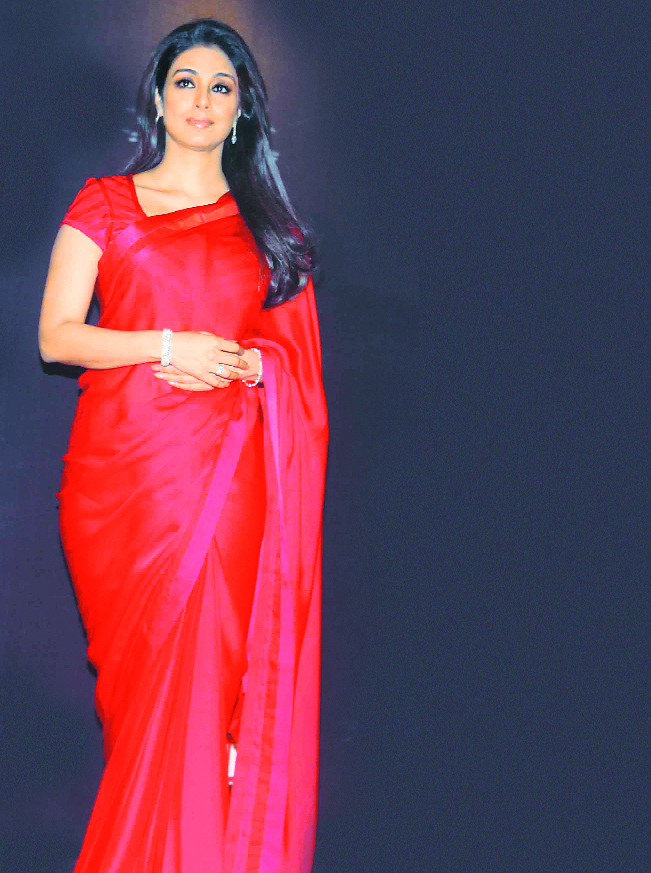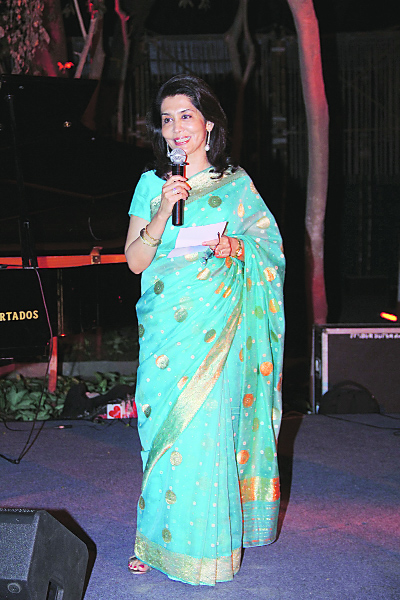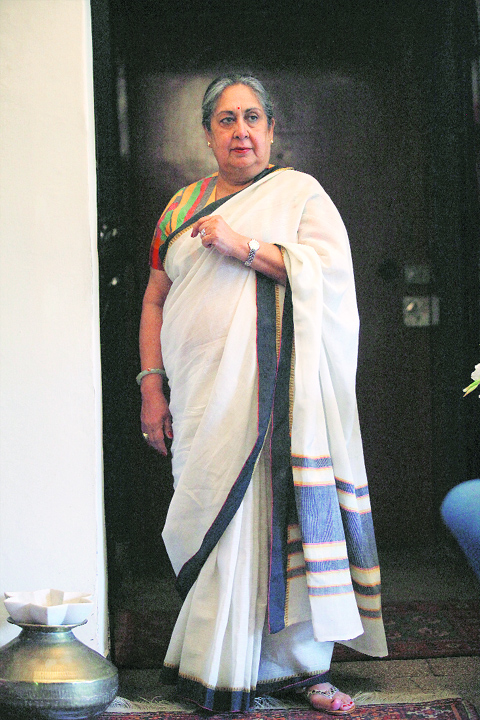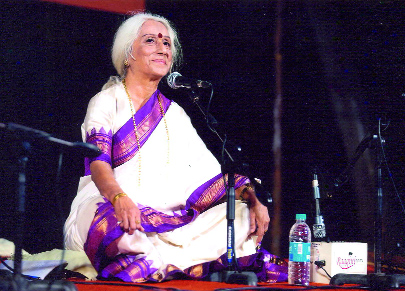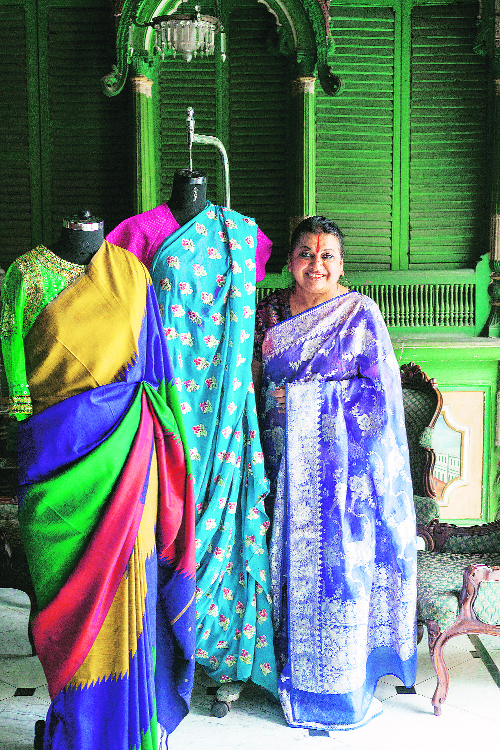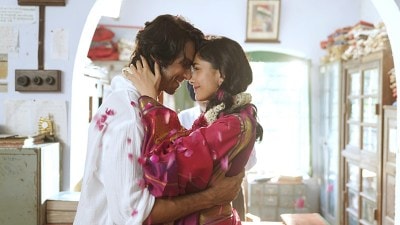- India
- International
Spin a Yarn: Women and their love affair with saree
We talk to women who have always disregarded the definition of a sari as a length of unstitched cloth.
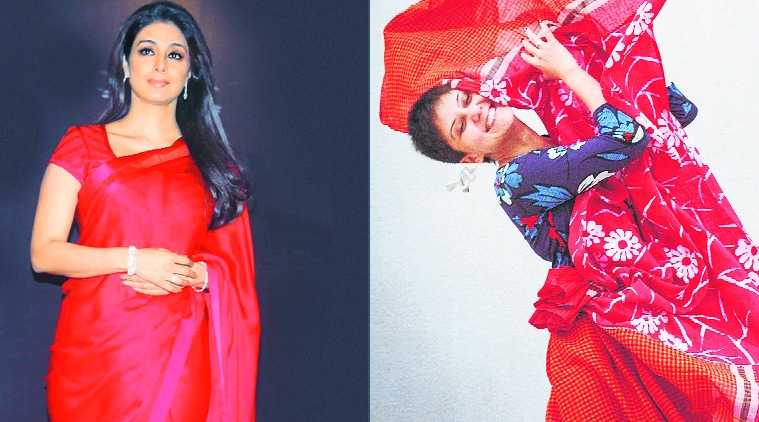 Sari love: Tabu and Swastika Mukherjee
Sari love: Tabu and Swastika Mukherjee
In March this year, friends and entrepreneurs Anju Maudgal Kadam and Ally Matthan made a pact: they would wear saris a 100 times by the end of 2015. Their #100sareepact caught the imagination of urban Indian women; the two women launched their own website. “The sari is now a medium to tell your story. An instance, a memory, something quirky, or just how you are feeling wearing it,” they wrote on the website. Soon enough, stories unfurled from across the country.
In this issue, we talk to women who have always disregarded the definition of a sari as a length of unstitched cloth. Like many others, for them the sari is a repository of family histories, of grandmothers and mothers passing on tradition wrapped up in nine yards, of experiments with drapes and a search for individual identity — a lifetime of gathering the pleats.
Rama Vaidyanathan, Bharatanatyam dancer
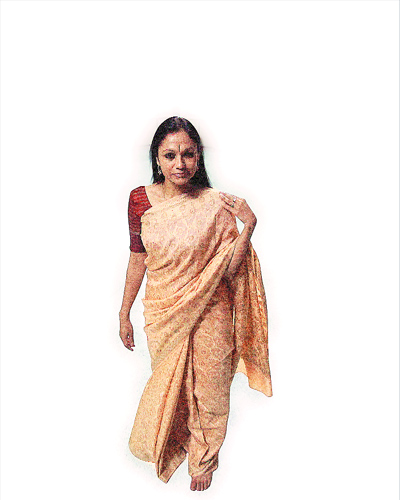
Rama Vaidyanathan’s tryst with saris didn’t begin until after she became a professional dancer. “People around me didn’t wear saris. I saw saris in my mother’s closet, and they were all Kanjeevarams,” says Vaidyanathan, 47. But once she took up dance, her mother’s saris came to her rescue.
Her wedding trousseau, too, comprised mostly Kanjeevarams, including family heirlooms. “For many years, my wardrobe overflowed with these bright woven silks in shades of mango, green and orange, among others,” says Vaidyanathan.
Almost 15 years ago, on a trip to Varanasi for a performance, Vaidyanathan came across a beautiful peach Banarasi silk. “Kanjeevarams are south India’s answer to Banarasis. As much as I like Kaanjeevarams, the Banarasi has a different lure. I was completely enamoured by the intricate Tanchoi (a weaving style) work on it. It came with beautiful floral motifs on the border and was a sharp contrast to the bright Kanjeevarams I had,” she says.

She hasn’t gotten over the lure of Kanjeevarams though. “Every time I wear it, I invariably pair it with a Kanjeevaram blouse. Old habits die hard,” she says.
– Suanshu Khurana
Tabu, actor
Growing up in Hyderabad, Tabu remembers her maternal grandmother wearing a Venkatagiri crisp cotton sari with a temple border every day, and changing into Kanjeevarams for weddings. Tabu’s mother, on the other hand, was a complete contrast with her printed georgette and chiffon saris in solid colours with khand blouses. Tabu followed in her footsteps: she wore a fuchsia chiffon sari in a song, Raahon mein unse mulakaat ho gayee, in Vijaypath (1994). The first time she draped a sari on screen was in her Telugu debut, Coolie No.1. “That too was a fuchsia sari,” she says. In her forthcoming film, Drishyam, she will be seen in an indigo Kalamkari sari.
The actor doesn’t collect saris but has a few special ones. “At a red carpet event, there’s always a debate over saris or gowns, but my outfit is determined by my mood. I always have a red and a black sari in my wardrobe, they are my go-to choices,” she says. For the Screen Awards this year, Tabu wore an Abu Jani-Sandeep Khosla red sari and diamond jewellery. “I wanted to keep it simple, red by itself makes a statement,” she says.
Ina Puri, art critic and curator
Ina Puri has a collection that boasts of saris from weavers across India: from Orissa to Chennai, from Banaras to Bengal. She took to wearing cotton saris in school and continued to do so during her college years at Kolkata’s Jadavpur University. “The influence of Shantiniketan was so strong that wearing saris came naturally to me,” she says. While Bengal cottons dominated her wardrobe back then, now she has weavers designing commissioned pieces. The recent acquisitions include a Byloom cotton from Kolkata. “It has a beautiful charcoal base and a thick vibrant border. It’s very dramatic and nuanced. It is pure cotton, I don’t touch synthetic,” says the 56-year-old, who stays away from designer saris. “They make me feel cold. My profession should reflect in the way I live, there has to be an aesthetic connect,” says Puri.
One of her most treasured possessions is a Pattan Patola commissioned to Vinayakbhai from Pattan. Introduced to her by artist Amit Ambalal, he took more than a year to design the garment. “It is a museum piece, in shades of deep red, cream and black,” says Puri, who has also been working on restoring heirloom saris from her collection. “The idea of a sari going extinct does not make sense to me, I wear one everyday,” she says. Some years ago, she approached Sanjay Garg of Raw Mango to restore her mother’s wedding Banarasi. “He painstakingly cut the small peacock motifs and put them onto another maroon/red saree. That too is very dear to me,” says Puri, who is hoping to pass her collection to her daughter-in-law. “I hope she will appreciate it and wear it,” she says.
– Vandana Kalra
Tasneem Zakaria Mehta, honorary director, Bhau Daji Lad Museum, Mumbai
It’s been 35 years since Tasneem Zakaria Mehta, honorary director, Bhau Daji Lad Museum in Mumbai first received the blue-and-gold Banarasi Jamdani sari (in picture). “It was gifted to me on my wedding day. It was already special because it was a part of my heritage,” she says. Mehta says that she fell in love with everything about that sari — the stunning colour and the pure gold zari embroidery that has not dulled over the years.
Mehta remembers the times as a young girl when she would play in her mother’s room while she dressed. “To our mothers, the sari was like second skin. They did all their household chores wearing one and yet managed to look beautiful and comfortable. And as a little girl, I couldn’t wait to grow up and wear one,” she says. When the time came for her to drape her first sari, the process had become so organic that no one had to teach her how wear one. “I knew exactly what to do with each drape.”
Since that first time, Mehta says she is most comfortable in a sari. “I wear it to work regularly. It’s the only garment that lends personality to the wearer, changing the way you walk, stand or sit,” she says. Mehta’s collection is quite enviable, but worries about passing it on to a generation that feels like it is to be worn only special occasions. “Young girls today have so much choice. But I’ve kept each one of my saris carefully, in the hope that one day my daughters will value them as much as I do.”
– Amruta Lakhe
Anavila Misra, fashion designer
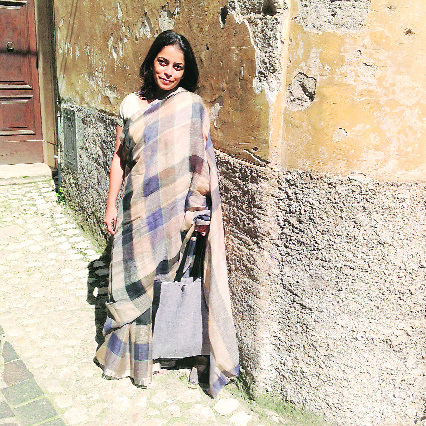
Designer Anavila Misra wore her first sari when she was 15. “I have loved saris since I was very young, but I wore my first sari on Diwali. It was a silk from my mother’s collection,” she says. Since then, the sari has grown to be a staple in her wardrobe and in her studio, where she experiments with the fabric, preferring to work with linen and keeping her designs simple. “I like saris which make you comfortable. So linen and cotton are my favourite sari fabrics,” she says. Misra’s favourite these days is a cement-and-indigo plaid sari that is part of her summer collection. She has even taken it along on her vacation to Italy. “Plaids with washed out colours are ever so country and vintage in their appeal, and yet so contemporary in the form of a sari. The one inch silver selvedge in the sari gives it a special detail,” she says.
– Paromita Chakrabarti
Malvika Singh, publisher, Seminar
In the last 49 years, Malvika Singh, 66, publisher, Seminar magazine, has collected over 700 saris. “I was nine when I received my first sari. It was a white Chanderi with a red and gold border in asli zari, with red butis all over, a gift from Leela Mulgaonkar (social activist),” she says.
Singh started wearing saris regularly after she turned 17. She sourced plain Mulmuls with thin borders from Mau in UP, and bought khadis from handloom outlets, “all cheap, cheerful and very reasonably priced,” she says. Printed cottons from Sanganer and Bagru, Ajrakhs and Leheriyas, cotton Bandhinis, Venkatagiris, Chettinad cottons and Kanjeevarams are all a part of her wardrobe.
After Singh got married, her mother bought her a sari from each of the great weaving traditions of India: Ikats from Orissa and Andhra, Chanderis, Banarasis, Tanchois, Paithanis, Jamdanis and Kalamkaris. Singh is wearing a handspun khadi sari with a black border and red selvedge, that she bought in Hyderabad.
– Pallavi Chattopadhyay
Prabha Atre, Indian classical vocalist
It was in 1948 that Prabha Atre, 83, classical vocalist of the Kirana gharana, wore her first sari: a plain cotton sari gifted by her mother. Not the kind of sari she would choose for herself. “Kanjeevaram, that’s my weakness. But we couldn’t afford it then,” she says.
Growing up in a middle-class family in Pune in the late ’40s, the sari was the only alternative to the “petticoat-blouse” teenagers would wear then. Seven decades on, she only wears “white Kanjeevarams with coloured borders. They are a part of my identity,” she says. Atre prefers to buy her own saris. In her collection, there is one that she holds dear, even though it’s no longer wearable. “It’s a white sari with a small border I wore to a Ganesh festival in 1980 in Pune. I have worn it to almost every big performance since,” she says.
– Alifiya Khan
Nimrat Kaur, actor
Before The Lunchbox became a huge international success and made actor Nimrat Kaur a household name, she had two Cannes Film Festival outings. And both times, she chose saris. When she made her red carpet debut at Cannes in 2012 for Peddlers, which was screened in the International Critics’ Week section, she borrowed a Sabyasachi sari from a friend. She returned to Cannes next year for The Lunchbox’s premiere under the same section. This time, she decided to go shopping. The first thing that caught her eye at Sabyasachi’s south Mumbai store was a black-and-white lehenga sari on a mannequin, with a flamenco flare. She instantly knew that’s the one she wanted. However, the price was beyond her budget. She sent a request to Sabyasachi, who very “graciously” let her wear it for the international event.
When D-Day came, the team’s packed schedule gave her very little time to dress up. The toughest task was hooking up the blouse buttons, all 85 of them, made of cloth. At the end of the day, “I was tired and my heel got stuck in the sari. I tripped on it and it ripped. When I came back, I was ready to pay for it, but Sabya did not let me,” she says.
– Alaka Sahani
Swastika Mukherjee, actor

You may recognise her as the femme fatale from Dibakar Banerjee’s Detective Byomkesh Bakshy!, but Swastika Mukherjee is considered Bengali cinema’s wild child. There is something liberating about the way Mukherjee embraces her oddities. “I dress the way I want to. Comfort is very important for me,” says Mukherjee. And she has experimented with saris long before it became a hashtag. “We were brought up to believe that the sari is such a formal attire. Yet, our mothers and grandmothers wear it all through the day without worrying about the pleats coming off. So I began wearing the sari with t-shirts,” says Mukherjee. Her first sari memory comes with a whiff of Napthalene balls. “My mother would bring out my grandmother’s wedding sari on special occasions. I would yearn for the day when I would be able to drape the Kashmiri silk with silver zari embroidery,” says Mukherjee. The sari she is posing in is a recent favourite, part of designer Sanjukta Roy’s gamchha collection. “It’s something that you will find in every east-Indian household. When converted into a sari, it is light and comfortable and perfect for summer,” she says.
– Premankur Biswas
Tisca Chopra, actor

Until about five years ago, Tisca Chopra, 41, felt that the sari, although beautiful, made her appear conventional. That was before she came across designers experimenting with saris. “I like my saris with a touch of whimsy. Animal motif on a classic weave or colourful embroidery on a linen piece makes the sari contemporary,” she says. Chopra feels even the simplest of saris look dramatic on her, perhaps because of her curvaceous figure. She prefers to wear saris for special occasions. “Among my favourites are several Anavila Misra saris and some by Raw Mango and Akaaro,” she says. The pride of her wardrobe, however, is a winter plaid linen sari from Anavila’s autumn-winter 2014 collection. “The print reminds me of a Scottish kilt, though its colours are inspired from the Mohenjodaro era. Because it’s linen, it drapes beautifully,” Chopra says.
– Dipti Nagpaul-D’Souza
Vinita Pittie, designer
For a designer who can dye her fabric in any colour, this particular sari (in purple) posed a challenge. Vinita Pittie received the Banarasi from her mother which has the most unusual “rubber stamp colour”. “My father got it sometime around 1952-’53. When I wear it today, I can’t find a blouse to match it. If you look at it closely, you would find that the motifs have similarities with the art and architecture of those times. I call them sibling patterns,” says Pittie.
But what she really treasures is the georgette handed down to her by her grandmother-in-law (in blue). “This was during the British rule in India. So people had access to European fabrics. She preferred pastels, rose pinks, aquamarines,” she says. Bought from yardage, this five-and-half-metre sari could have also turned into a dress material. “My grandmother-in-law would always store her saris in pre-washed muslin cloth, four to one, packed with a pin and a tag which said what was within.”
– Shiny Varghese
Mini Mathur, television anchor
In vibrant-hued handloom saris, Mini Mathur stands out from the sea of celebrities in prêt designer wear. “I have been wearing saris since I was in college in Delhi,” she says. While hosting Indian Idol in 2005, Mathur began wearing colourful saris with printed blouses. “Soon after, I started wearing bright cotton saris to red carpet events,” she says. A lover of textiles, she hates synthetic, net and swarovski-encrusted saris and shops from indigenous artists across India. “Soaps have ruined the image of saris,” says the former VJ. Mathur recently launched a limited edition line of cotton saris and owns nearly 100 saris, some of which have been inherited from her mother. Her favourite is a Raw Mango lime green cotton sari with a radiant pink border (in picture). “It was my first bright-coloured Raw Mango sari,” she says.
– Shikha Kumar
Rajshree Pathy, entrepreneur

As chairperson and managing director of Rajshree Sugars and Chemicals Limited and founder of the India Design Forum, Rajshree Pathy’s days are packed with activities that include meetings with heads of state as well as young talent in design. For most of these occasions, her sartorial choice includes a sari. “Every time I wear my favourite Pattan Patola sari, I feel like a queen. It’s like owning a piece of history. It is a heritage double Ikat fabric manufactured only by very few skilled families from Pattan in Gujrat. My mother had a few which she got made decades ago. I had one produced along with (classical dancers) Mrinalini and Mallika Sarabhai in the 1990s,” she recalls.
Pathy wears it to weddings, dinners and official meetings, one such being a dinner thrown for former US President Bill Clinton on his visit to India. “To most observers, it is just an elegant silk sari, but this Pattan Patola is exquisite in its weave. Both sides are similar, and each thread is dipped in organic dyes; the indigo and the red are my favourite Patola combinations. It is a piece of ‘endangered luxury’,” she says.
– Shiny Varghese
More Lifestyle
Apr 25: Latest News
- 01
- 02
- 03
- 04
- 05


